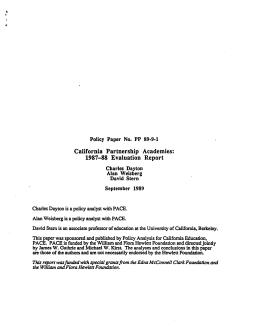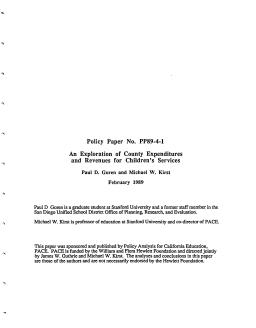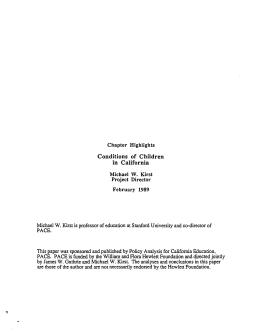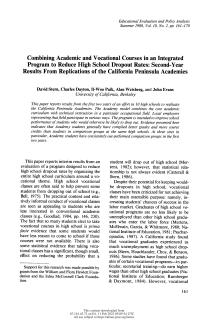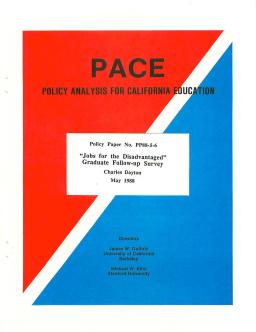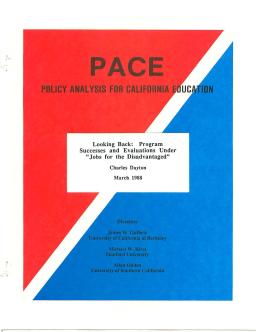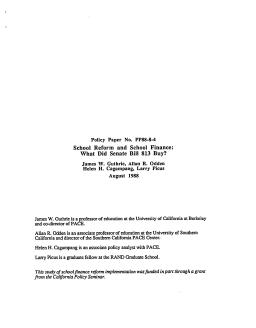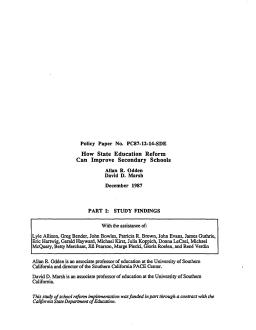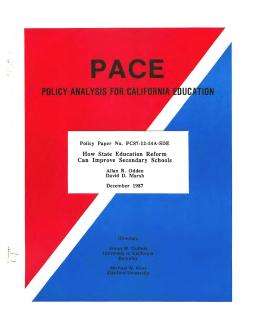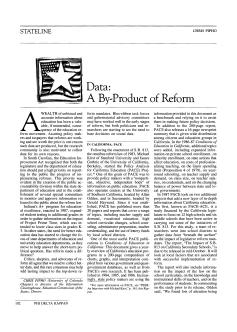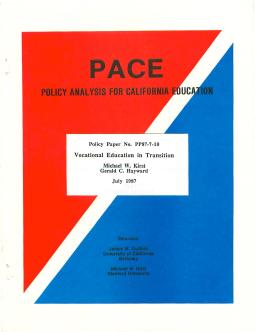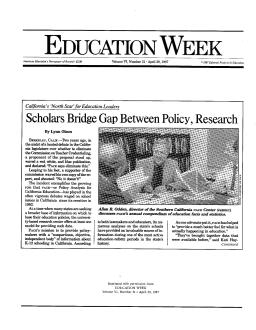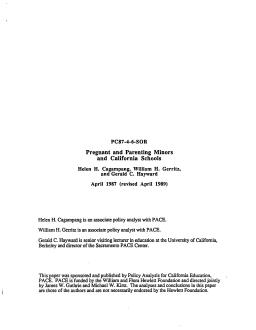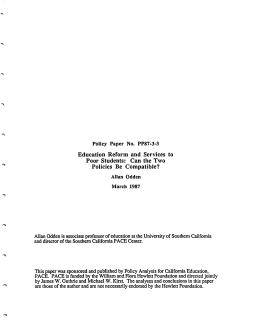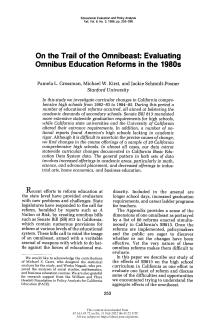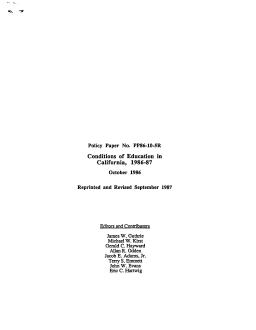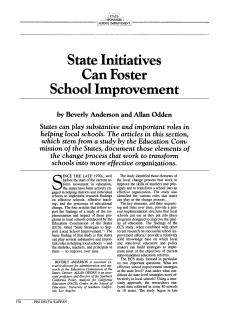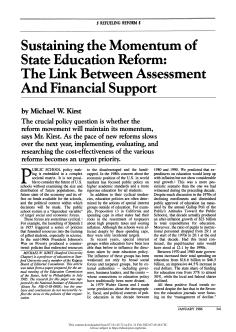1987–88 Evaluation Report
Published
Summary
This report presents findings from the third annual evaluation of Partnership Academy Programs in CA, a high school-based, state-funded program with a school-within-a-school administrative structure that enrolls at-risk students with academic potential. The program provides students with basic job skills in a promising labor-market field and support from local businesses, including curriculum development, guest speakers, field trips, mentors, and work experience positions. The evaluation addresses the quality of program implementation and the degree to which programs follow the academy model.
A Hypothetical Account and Research Review
Published
Summary
This paper discusses childcare quality and its impact on child development. It highlights the need to consider various factors that contribute to quality and how they affect children's experiences. Presented is a hypothetical day in two different childcare situations to demonstrate the varying experiences children have. The characters and incidents are fictional but based on the author's real observations and experiences in early childhood programs in CA. The author emphasizes the need to promote quality early childhood programs informed by research in child development and early education.
Third-Year Results from Replications of the California Peninsula Academies
Published
Summary
Evaluation of 11 California high school academies in 1987-88 found positive in-school outcomes. Academies combine academic and vocational courses to reduce dropout rates. Graduation rates available for one grade-level cohort, with an estimated net benefit of $1.0-1.3 million from dropout prevention.
An Exploration of the Debate on School District Size
Published
Summary
The notion that larger school districts are superior has changed, with some researchers advocating for smaller ones. Recent reform reports have focused on the school site as the decision-making seat. Three main issues guide district size research: fiscal efficiency, school effectiveness, and community identity. Although research has been conducted, there is still no definitive answer. This article explores the research and debate on the "right" size for school districts and identifies unanswered questions, hoping to kindle interest in further research.
Published
Summary
California's growing child population will require significant increases in public spending, particularly in education due to immigration, working parents, poverty, and family disorganization. Counties and school districts bear the brunt of providing children's services, but cities have greater fiscal flexibility and revenue-raising potential. This paper provides information on county children's services and trends in county budgets to support further research on county financing for children's services.
Chapter Highlights
Published
Summary
This report provides social indicators to evaluate the quality of life for children in California, covering physical and mental health, safety, sexual behavior, academic achievement, and the settings and systems that serve children. Despite most children being healthier and better schooled than in the past, recent polls indicate concern about child-rearing and the likelihood of an expanding educational underclass. The report aims to offer a portrait of the quality of California's children, address gaps in available data, and provide limited policy recommendations.
Second-Year Results from Replications of the California Peninsula Academies
Published
Summary
This article discusses the results of replicating the California Peninsula Academies model in 10 high schools. The model provides technical instruction in an occupational field, alongside core academic curriculum, and is designed to prevent dropouts. Evidence suggests that Academy students performed better in terms of grades and course credits compared to students in comparison groups, particularly at three sites.
Graduate Follow-up Survey
Published
Summary
A survey was conducted on the first class of participants in the "Jobs for the Disadvantaged" program and a comparison group six months after graduation. Although the sample size was small, a significantly higher percentage of program participants graduated on time than the comparison group. About half of both groups were in postgraduate schooling, but more program graduates were working. Among those in school, few differences were found. For those working, twice as many program graduates secured work through school, but comparison-group graduates had somewhat higher wages.
1986–87 Evaluation Report
Published
Summary
In the fall of 1985, ten academy programs were established by the State of California as replications of the Peninsula Academies. Policy Analysis for California Education (PACE) evaluated these 10 academies in 1985–86. This report presents findings from a second evaluation covering the academies' 1986–87 school year.
Program Successes and Evaluations Under 'Jobs for the Disadvantaged'
Published
Summary
This report discusses the challenges of implementing broad state-level initiatives to reform schools in California, following the passage of S.B. 813 in 1983. While earlier studies showed the formal implementation of these reforms, their impact on local schools and substantive changes remained unclear. The article uses data to answer the question of whether these state-level initiatives can improve local schools, concluding that successful implementation depends on several factors. The evaluations also revealed lessons about conducting evaluations and obtaining necessary data from schools.
Published
Summary
The fourth edition of Conditions of Education in California has expanded its content to include a special features section on education reform processes, along with the previously included sections. The publication is based on compiled information from other sources and original data collection and analysis. The format has been altered to improve readability for a wide range of audiences.
Study Findings
Published
Summary
In 1983, California's Senate Bill 813 aimed to improve the education system by proposing a large number of reforms. However, it lacked a cohesive strategy and proven philosophy. The bill's impact on school districts and schools was unknown, and this study aimed to assess whether selected schools could implement the reform components and whether they contributed to school improvement. The goal was to understand how schools reacted to state mandates and inducements for improvement.
A Preschool Through High School Concern
Published
Summary
This report explores why thousands of students continue to drop out despite the belief that education is necessary for success. By examining dropout characteristics and behavior from preschool through high school, it presents the experience of selected dropout prevention programs. Focusing on the specific act of dropping out may neglect earlier clues, so understanding students' experiences as they progress through grades is crucial for effective prevention strategies.
Background and Technical Appendices
Published
Summary
California's education system faced a decline in the early 1980s, prompting reforms such as a common core curriculum, higher graduation requirements, and tougher academic standards. A Nation at Risk report further pushed for nationwide school changes. California's swift response led to the enactment of Senate Bill 813, a comprehensive education reform program with over 80 policy and program reforms. Several studies showed positive results, but the study in this report aims to determine how state-level education reforms improved local schools.
A By-Product of Reform
Published
Summary
The Policy Analysis for California Education (PACE) Project provides nonpartisan information to policymakers about California's education system. Their "Conditions of Education in California" report is a yearly benchmark for policymakers. PACE also studies in-depth information on California's education system, including the impact of legislation on schools and the performance of students. Their research is widely distributed among education groups and citizens.
Published
Summary
This report discusses the decline in vocational education enrollment in California and its potential impact on noncollege-bound students' high school completion rates. Questions remain about the objectives of vocational education and whether it should prioritize skill training for entry-level jobs or emphasize academic skills for a working life of continual learning. PACE recommends a re-examination of curricular changes with a special focus on transitions occurring in vocational education due to enrollment declines and changes in the US job structure.
A Study of Year-Round Education in California
Published
Summary
As California schools face increasing enrollment and competition for resources, many have turned to year-round education as a solution. However, little is known about the educational impact of year-round programs. This report analyzes and synthesizes information on all schools with year-round programs in California, presenting issues to inform decision makers at both local and statewide levels. It is the first attempt to provide a statewide perspective on year-round education.
Published
Summary
PACE, a university-based research center, provides "nonpartisan, objective, independent" information on K-12 schooling in CA. Its analyses have been invaluable to lawmakers and educators during the state's active education-reform period. PACE has played a growing role in debates on school issues, exemplified by a heated debate in the CA legislature over the Commission on Teacher Credentialing. PACE offers a model for providing data for education policies when many states are seeking broader information bases. It has helped provide a better understanding of what is happening in education.
Published
Summary
The California Senate Office of Research has commissioned PACE to investigate how to expand public school programs to reduce dropout rates for high-risk students, particularly pregnant and parenting adolescents. The study involves examining secondary sources, conducting surveys of junior and senior high schools, unified and high school districts, and assessing implementation costs. The project is funded in part by the National Conference of State Legislators and the United States Office of Educational Research and Improvement.
Can the Two Policies Be Compatible?
Published
Summary
California adopts strategies to fuse comprehensive education reforms with special-needs curricular services for economically disadvantaged students. Both compliance and assistance mechanisms, as well as top-down and bottom-up tactics, are key to improving education for regular and categorical program students. Evidence suggests excellence and equity are compatible, but whether these strategies improve student performance is unclear.
1985–86 Evaluation Report
Published
Summary
Peninsula Academies are three-year high school programs designed for at-risk students, combining academic and technical training. Since 1981, they've been operating in California, and in 1985, ten new programs were created under state sponsorship. This report evaluates the quality of implementation and evidence of measurable impact on students after the first year. The report is based on site visits, questionnaire responses, and student data gathered from each high school. The Academy model is complex, but some sites didn't fully realize all components.
Evaluating Omnibus Education Reforms in the 1980s
Published
Summary
The study examines curricular changes in California's high schools from 1982 to 1985, a period of educational reforms aimed at increasing academic rigor. The state mandated more extensive graduation requirements while universities adjusted their entrance requirements. A sample of 20 comprehensive high schools shows increased academic offerings in math, science, and advanced placement, and decreased offerings in industrial arts, home economics, and business education, reflect statewide trends.
Published
Summary
Continuing growth and sustained progress on educational reform characterize California's public schools, but the Gann spending limit, which potentially restricts state dollars for education, and projected shortages of highly qualified teachers dampen prospects for continued educational improvements. Indications of important educational progress in California, which PACE documented in Conditions of Education in California, 1985, continue on many fronts. This is particularly true when compared to the recent decade of serious decline in California's public school system.
Published
Summary
States can help local schools improve by implementing effective school improvement strategies. A study by the Education Commission of the States (ECS) identified key elements that can transform schools into more effective organizations, and various roles that states can play in the change process. The study analyzed data collected in 40 schools in 10 states, providing a solid knowledge base for implementing state-mandated education reforms. Effective strategies and conditions for success were studied using a case-study approach. The study began in late 1983 and was completed in early 1985.
The Link Between Assessment and Financial Support
Published
Summary
Public school policy making is embedded in a complex societal matrix. It is not possible to consider the future of U.S. schools without examining the size and distribution of future populations; the future state of the economy and its effect on funds available for the schools; and the political context within which decisions will be made. The public school system is a "dependent variable" of larger social and economic forces.
